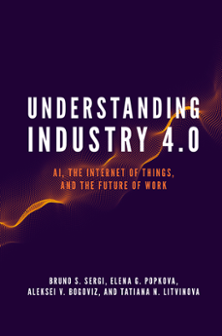
Index
Understanding Industry 4.0: AI, the Internet of Things, and the Future of Work
ISBN: 978-1-78973-312-9, eISBN: 978-1-78973-311-2
Publication date: 2 September 2019
Citation
Sergi, B.S., Popkova, E.G., Bogoviz, A.V. and Litvinova, T.N. (2019), "Index", Understanding Industry 4.0: AI, the Internet of Things, and the Future of Work, Emerald Publishing Limited, Leeds, pp. 223-229. https://doi.org/10.1108/978-1-78973-311-220191003
Publisher
:Emerald Publishing Limited
Copyright © 2019 Emerald Publishing Limited
INDEX
Index
- Prelims
- Part I: Overview of Future Professions in Industry
- Chapter 1: Outlines of the Context for Industry 4.0
- Chapter 2: Future Professions in Industry
- Chapter 3: Map of Competences for Representatives of Future Professions in Industry
- Part II: Future Professions in Agriculture
- Chapter 4: Future Outlines of Agriculture in the Agro-Industrial Complex 4.0
- Chapter 5: Future Professions in Agriculture
- Chapter 6: Map of Competences for Representatives of Future Professions in Agriculture
- Part III: Future Professions in Medicine
- Chapter 7: Future Outlines of Medicine at the Threshold of a Genetic Revolution
- Chapter 8: Future Professions in Medicine
- Chapter 9: Map of Competences for Representatives of Future Professions in Medicine
- Part IV: Future Planned Professions in Education
- Chapter 10: Future Outlines in the Sphere of Education in the Age of the Information Economy
- Chapter 11: Future Professions in Education
- Chapter 12: Map of Competences for Representatives of Future Professions in Education
- Part V: Expected Professions in Body Care and Fitness
- Chapter 13: Future Outlines of the Body Care and Fitness Sector
- Chapter 14: Future Professions in Body Care and Fitness
- Chapter 15: The Map of Competences for Representatives of Future Professions in Body Care and Fitness
- Part VI: The Key Future Professions in R&D
- Chapter 16: The Future Outline of the R&D Sector in the Context of the Formation of the Innovation Economy
- Chapter 17: Future Professions in R&D
- Chapter 18: The Map of Competences for Representatives of Future Professions in R&D
- Part VII: Perspectives on Future Professions in Transport and Communications
- Chapter 19: Future Outline of the Transport and Communications Sector in the Context of a Revolution in Information Communication Technologies
- Chapter 20: Future Professions in Transport and Communications
- Chapter 21: The Map of Competences for Representatives of Future Professions in Transport and Communications
- Part VIII: Recommendations for Successful Modern Workers
- Chapter 22: Common Features and Competences that are Necessary for All Future Professions
- Chapter 23: The Concept of Lifelong Learning as the Basis for Mastering Future Professions
- Chapter 24: An Algorithm for Selecting and Mastering Future Professions
- Chapter 25: The Model of State Management for the Process of Selecting and Mastering Future Professions
- Conclusions
- List of Acronyms
- References
- Index